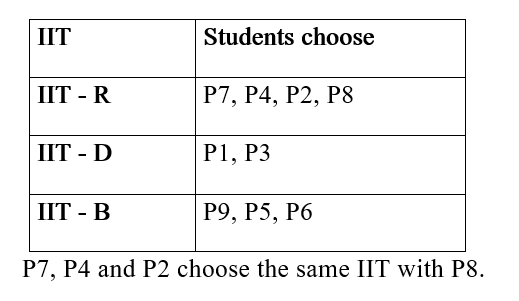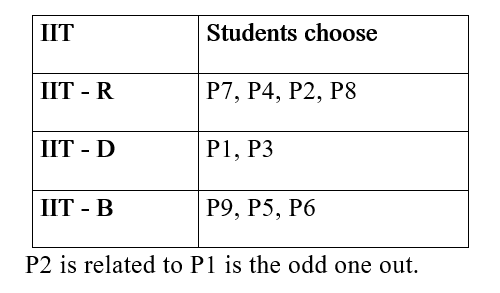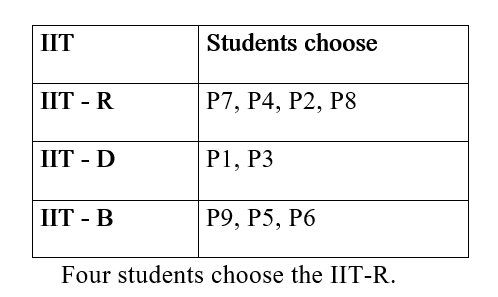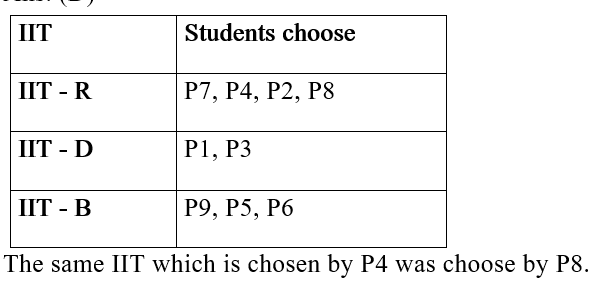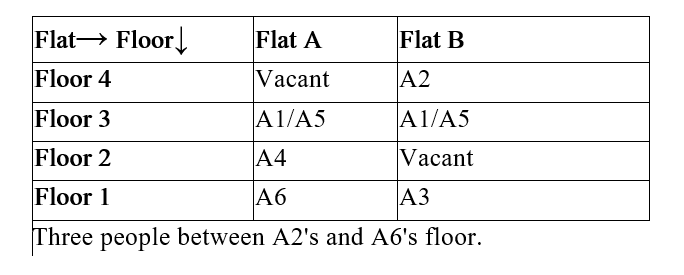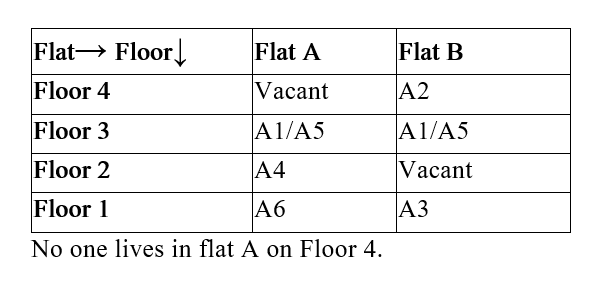Question 1:
Directions: There are nine students P1, P2, P3, P4, P5, P6, P7, P8 and P9, who choose three different IIT for further studies i.e. IIT-R, IIT-D and IIT-B. At least two and not more than four people choose the same IIT.
P9 choose IIT-B, but not with P7. Only P1 and P3 choose the same IIT. P4 and P2 choose the same IIT. P8 and P9 did not choose the same IIT. P7 choose IIT-R for further studies. P5 and P4 did not choose the same IIT. P4 and P7 choose the same IIT for further studies.
निर्देश: नौ विद्यार्थी P1, P2, P3, P4, P5, P6, P7, P8 और P9 आगे की पढ़ाई के लिए तीन अलग-अलग IIT अर्थात IIT-R, IIT-D और IIT-B का चयन करते हैं। कम से कम दो और अधिक से अधिक चार व्यक्ति समान IIT का चयन करते हैं।
P9, IIT-B का चयन करता है लेकिन P7 के साथ नहीं। केवल P1 और P3 समान IIT का चयन करते हैं। P4 और P2 समान IIT का चयन करते हैं। P8 और P9 ने समान IIT का चयन नहीं किया है। P7 ने आगे की पढ़ाई के लिए IIT-R का चयन किया है। P5 और P4 ने समान IIT का चयन नहीं किया है। P4 और P7 आगे की पढ़ाई के लिए समान IIT का चयन करते हैं।
Who among the following choose the same IIT with P8?
निम्नलिखित में से कौन P8 के साथ समान IIT का चयन करता है?
Question 2:
Directions: There are nine students P1, P2, P3, P4, P5, P6, P7, P8 and P9, who choose three different IIT for further studies i.e. IIT-R, IIT-D and IIT-B. At least two and not more than four people choose the same IIT.
P9 choose IIT-B, but not with P7. Only P1 and P3 choose the same IIT. P4 and P2 choose the same IIT. P8 and P9 did not choose the same IIT. P7 choose IIT-R for further studies. P5 and P4 did not choose the same IIT. P4 and P7 choose the same IIT for further studies.
निर्देश: नौ विद्यार्थी P1, P2, P3, P4, P5, P6, P7, P8 और P9 आगे की पढ़ाई के लिए तीन अलग-अलग IIT अर्थात IIT-R, IIT-D और IIT-B का चयन करते हैं। कम से कम दो और अधिक से अधिक चार व्यक्ति समान IIT का चयन करते हैं।
P9, IIT-B का चयन करता है लेकिन P7 के साथ नहीं। केवल P1 और P3 समान IIT का चयन करते हैं। P4 और P2 समान IIT का चयन करते हैं। P8 और P9 ने समान IIT का चयन नहीं किया है। P7 ने आगे की पढ़ाई के लिए IIT-R का चयन किया है। P5 और P4 ने समान IIT का चयन नहीं किया है। P4 और P7 आगे की पढ़ाई के लिए समान IIT का चयन करते हैं।
Who among the following choose the IIT-D?
निम्नलिखित में से कौन IIT-D का चयन करता है?
Question 3:
Directions: There are nine students P1, P2, P3, P4, P5, P6, P7, P8 and P9, who choose three different IIT for further studies i.e. IIT-R, IIT-D and IIT-B. At least two and not more than four people choose the same IIT.
P9 choose IIT-B, but not with P7. Only P1 and P3 choose the same IIT. P4 and P2 choose the same IIT. P8 and P9 did not choose the same IIT. P7 choose IIT-R for further studies. P5 and P4 did not choose the same IIT. P4 and P7 choose the same IIT for further studies.
निर्देश: नौ विद्यार्थी P1, P2, P3, P4, P5, P6, P7, P8 और P9 आगे की पढ़ाई के लिए तीन अलग-अलग IIT अर्थात IIT-R, IIT-D और IIT-B का चयन करते हैं। कम से कम दो और अधिक से अधिक चार व्यक्ति समान IIT का चयन करते हैं।
P9, IIT-B का चयन करता है लेकिन P7 के साथ नहीं। केवल P1 और P3 समान IIT का चयन करते हैं। P4 और P2 समान IIT का चयन करते हैं। P8 और P9 ने समान IIT का चयन नहीं किया है। P7 ने आगे की पढ़ाई के लिए IIT-R का चयन किया है। P5 और P4 ने समान IIT का चयन नहीं किया है। P4 और P7 आगे की पढ़ाई के लिए समान IIT का चयन करते हैं।
Find the odd one out.
असंगत ज्ञात कीजिए।
Question 4:
Directions: There are nine students P1, P2, P3, P4, P5, P6, P7, P8 and P9, who choose three different IIT for further studies i.e. IIT-R, IIT-D and IIT-B. At least two and not more than four people choose the same IIT.
P9 choose IIT-B, but not with P7. Only P1 and P3 choose the same IIT. P4 and P2 choose the same IIT. P8 and P9 did not choose the same IIT. P7 choose IIT-R for further studies. P5 and P4 did not choose the same IIT. P4 and P7 choose the same IIT for further studies.
निर्देश: नौ विद्यार्थी P1, P2, P3, P4, P5, P6, P7, P8 और P9 आगे की पढ़ाई के लिए तीन अलग-अलग IIT अर्थात IIT-R, IIT-D और IIT-B का चयन करते हैं। कम से कम दो और अधिक से अधिक चार व्यक्ति समान IIT का चयन करते हैं।
P9, IIT-B का चयन करता है लेकिन P7 के साथ नहीं। केवल P1 और P3 समान IIT का चयन करते हैं। P4 और P2 समान IIT का चयन करते हैं। P8 और P9 ने समान IIT का चयन नहीं किया है। P7 ने आगे की पढ़ाई के लिए IIT-R का चयन किया है। P5 और P4 ने समान IIT का चयन नहीं किया है। P4 और P7 आगे की पढ़ाई के लिए समान IIT का चयन करते हैं।
How many students choose the IIT-R?
कितने विद्यार्थी IIT-R का चयन करते हैं?
Question 5:
Directions: There are nine students P1, P2, P3, P4, P5, P6, P7, P8 and P9, who choose three different IIT for further studies i.e. IIT-R, IIT-D and IIT-B. At least two and not more than four people choose the same IIT.
P9 choose IIT-B, but not with P7. Only P1 and P3 choose the same IIT. P4 and P2 choose the same IIT. P8 and P9 did not choose the same IIT. P7 choose IIT-R for further studies. P5 and P4 did not choose the same IIT. P4 and P7 choose the same IIT for further studies.
निर्देश: नौ विद्यार्थी P1, P2, P3, P4, P5, P6, P7, P8 और P9 आगे की पढ़ाई के लिए तीन अलग-अलग IIT अर्थात IIT-R, IIT-D और IIT-B का चयन करते हैं। कम से कम दो और अधिक से अधिक चार व्यक्ति समान IIT का चयन करते हैं।
P9, IIT-B का चयन करता है लेकिन P7 के साथ नहीं। केवल P1 और P3 समान IIT का चयन करते हैं। P4 और P2 समान IIT का चयन करते हैं। P8 और P9 ने समान IIT का चयन नहीं किया है। P7 ने आगे की पढ़ाई के लिए IIT-R का चयन किया है। P5 और P4 ने समान IIT का चयन नहीं किया है। P4 और P7 आगे की पढ़ाई के लिए समान IIT का चयन करते हैं।
Which IIT is chosen by P8?
P8 के द्वारा कौन-से IIT का चयन किया गया है?
Question 6:
Directions: Six people A1, A2, A3, A4, A5 and A6 are living in a four-storey building, where the ground floor is numbered as floor 1 and the topmost floor is numbered as floor 4. Each floor has two flats i.e. Flat A and Flat B. Flat A is west of Flat B. There are two flats vacant in the building.
Note: Flat A of floor 1 is immediately below Flat A of floor 2 and so on.
A6 lives in flat A on an odd-numbered floor. A4 lives immediately above A6 in the same flat. A1 and A5 live on the same floor. No flat on an odd-numbered floor is vacant. There are two floors between A2 and A3. A2 lives above A3 in the same flat. No one lives to the east and west of A4.
निर्देश: छह व्यक्ति A1, A2, A3, A4, A5 और A6 एक चार मंजिला इमारत में रहते हैं, जहाँ सबसे निचली मंजिल को मंजिल 1 के रूप में संख्यांकित किया गया है और सबसे ऊपरी मंजिल को मंजिल 4 के रूप में संख्यांकित किया गया है। प्रत्येक मंजिल में दो फ्लैट अर्थात फ्लैट A और फ्लैट B हैं। फ्लैट A, फ्लैट B के पश्चिम में है। इस इमारत में दो फ्लैट खाली हैं।
नोट: मंजिल 1 का फ्लैट A, मंजिल 2 के फ्लैट A के ठीक नीचे है और इस प्रकार आगे।
A6 एक विषम संख्या वाली मंजिल पर फ्लैट A में रहता है। A4 समान फ्लैट में A6 के ठीक ऊपर रहता है। A1 और A5 समान मंजिल पर रहते हैं। एक विषम संख्या वाली मंजिल पर कोई भी फ्लैट खाली नहीं है। A2 और A3 के मंजिलों के बीच में दो मंजिलें हैं। A2 समान फ्लैट में A3 के ऊपर रहता है। A4 के पूर्व और पश्चिम में कोई व्यक्ति नहीं रहता है।
Who among the following lives immediately above A4's floor?
निम्नलिखित में से कौन-सा/से व्यक्ति A4 के मंजिल के ठीक ऊपर रहता/रहते है/हैं?
Question 7:
Directions: Six people A1, A2, A3, A4, A5 and A6 are living in a four-storey building, where the ground floor is numbered as floor 1 and the topmost floor is numbered as floor 4. Each floor has two flats i.e. Flat A and Flat B. Flat A is west of Flat B. There are two flats vacant in the building.
Note: Flat A of floor 1 is immediately below Flat A of floor 2 and so on.
A6 lives in flat A on an odd-numbered floor. A4 lives immediately above A6 in the same flat. A1 and A5 live on the same floor. No flat on an odd-numbered floor is vacant. There are two floors between A2 and A3. A2 lives above A3 in the same flat. No one lives to the east and west of A4.
निर्देश: छह व्यक्ति A1, A2, A3, A4, A5 और A6 एक चार मंजिला इमारत में रहते हैं, जहाँ सबसे निचली मंजिल को मंजिल 1 के रूप में संख्यांकित किया गया है और सबसे ऊपरी मंजिल को मंजिल 4 के रूप में संख्यांकित किया गया है। प्रत्येक मंजिल में दो फ्लैट अर्थात फ्लैट A और फ्लैट B हैं। फ्लैट A, फ्लैट B के पश्चिम में है। इस इमारत में दो फ्लैट खाली हैं।
नोट: मंजिल 1 का फ्लैट A, मंजिल 2 के फ्लैट A के ठीक नीचे है और इस प्रकार आगे।
A6 एक विषम संख्या वाली मंजिल पर फ्लैट A में रहता है। A4 समान फ्लैट में A6 के ठीक ऊपर रहता है। A1 और A5 समान मंजिल पर रहते हैं। एक विषम संख्या वाली मंजिल पर कोई भी फ्लैट खाली नहीं है। A2 और A3 के मंजिलों के बीच में दो मंजिलें हैं। A2 समान फ्लैट में A3 के ऊपर रहता है। A4 के पूर्व और पश्चिम में कोई व्यक्ति नहीं रहता है।
How many people live between A2's and A6's floors?
A2 और A6 के मंजिलों के बीच में कितने व्यक्ति रहते हैं?
Question 8:
Directions: Six people A1, A2, A3, A4, A5 and A6 are living in a four-storey building, where the ground floor is numbered as floor 1 and the topmost floor is numbered as floor 4. Each floor has two flats i.e. Flat A and Flat B. Flat A is west of Flat B. There are two flats vacant in the building.
Note: Flat A of floor 1 is immediately below Flat A of floor 2 and so on.
A6 lives in flat A on an odd-numbered floor. A4 lives immediately above A6 in the same flat. A1 and A5 live on the same floor. No flat on an odd-numbered floor is vacant. There are two floors between A2 and A3. A2 lives above A3 in the same flat. No one lives to the east and west of A4.
निर्देश: छह व्यक्ति A1, A2, A3, A4, A5 और A6 एक चार मंजिला इमारत में रहते हैं, जहाँ सबसे निचली मंजिल को मंजिल 1 के रूप में संख्यांकित किया गया है और सबसे ऊपरी मंजिल को मंजिल 4 के रूप में संख्यांकित किया गया है। प्रत्येक मंजिल में दो फ्लैट अर्थात फ्लैट A और फ्लैट B हैं। फ्लैट A, फ्लैट B के पश्चिम में है। इस इमारत में दो फ्लैट खाली हैं।
नोट: मंजिल 1 का फ्लैट A, मंजिल 2 के फ्लैट A के ठीक नीचे है और इस प्रकार आगे।
A6 एक विषम संख्या वाली मंजिल पर फ्लैट A में रहता है। A4 समान फ्लैट में A6 के ठीक ऊपर रहता है। A1 और A5 समान मंजिल पर रहते हैं। एक विषम संख्या वाली मंजिल पर कोई भी फ्लैट खाली नहीं है। A2 और A3 के मंजिलों के बीच में दो मंजिलें हैं। A2 समान फ्लैट में A3 के ऊपर रहता है। A4 के पूर्व और पश्चिम में कोई व्यक्ति नहीं रहता है।
Find the odd one out.
असंगत ज्ञात कीजिए।
Question 9:
Directions: Six people A1, A2, A3, A4, A5 and A6 are living in a four-storey building, where the ground floor is numbered as floor 1 and the topmost floor is numbered as floor 4. Each floor has two flats i.e. Flat A and Flat B. Flat A is west of Flat B. There are two flats vacant in the building.
Note: Flat A of floor 1 is immediately below Flat A of floor 2 and so on.
A6 lives in flat A on an odd-numbered floor. A4 lives immediately above A6 in the same flat. A1 and A5 live on the same floor. No flat on an odd-numbered floor is vacant. There are two floors between A2 and A3. A2 lives above A3 in the same flat. No one lives to the east and west of A4.
निर्देश: छह व्यक्ति A1, A2, A3, A4, A5 और A6 एक चार मंजिला इमारत में रहते हैं, जहाँ सबसे निचली मंजिल को मंजिल 1 के रूप में संख्यांकित किया गया है और सबसे ऊपरी मंजिल को मंजिल 4 के रूप में संख्यांकित किया गया है। प्रत्येक मंजिल में दो फ्लैट अर्थात फ्लैट A और फ्लैट B हैं। फ्लैट A, फ्लैट B के पश्चिम में है। इस इमारत में दो फ्लैट खाली हैं।
नोट: मंजिल 1 का फ्लैट A, मंजिल 2 के फ्लैट A के ठीक नीचे है और इस प्रकार आगे।
A6 एक विषम संख्या वाली मंजिल पर फ्लैट A में रहता है। A4 समान फ्लैट में A6 के ठीक ऊपर रहता है। A1 और A5 समान मंजिल पर रहते हैं। एक विषम संख्या वाली मंजिल पर कोई भी फ्लैट खाली नहीं है। A2 और A3 के मंजिलों के बीच में दो मंजिलें हैं। A2 समान फ्लैट में A3 के ऊपर रहता है। A4 के पूर्व और पश्चिम में कोई व्यक्ति नहीं रहता है।
Who among the following lives in flat A on Floor 4?
निम्नलिखित में से कौन मंजिल 4 पर फ्लैट A में रहता है?
Question 10:
Directions: Six people A1, A2, A3, A4, A5 and A6 are living in a four-storey building, where the ground floor is numbered as floor 1 and the topmost floor is numbered as floor 4. Each floor has two flats i.e. Flat A and Flat B. Flat A is west of Flat B. There are two flats vacant in the building.
Note: Flat A of floor 1 is immediately below Flat A of floor 2 and so on.
A6 lives in flat A on an odd-numbered floor. A4 lives immediately above A6 in the same flat. A1 and A5 live on the same floor. No flat on an odd-numbered floor is vacant. There are two floors between A2 and A3. A2 lives above A3 in the same flat. No one lives to the east and west of A4.
निर्देश: छह व्यक्ति A1, A2, A3, A4, A5 और A6 एक चार मंजिला इमारत में रहते हैं, जहाँ सबसे निचली मंजिल को मंजिल 1 के रूप में संख्यांकित किया गया है और सबसे ऊपरी मंजिल को मंजिल 4 के रूप में संख्यांकित किया गया है। प्रत्येक मंजिल में दो फ्लैट अर्थात फ्लैट A और फ्लैट B हैं। फ्लैट A, फ्लैट B के पश्चिम में है। इस इमारत में दो फ्लैट खाली हैं।
नोट: मंजिल 1 का फ्लैट A, मंजिल 2 के फ्लैट A के ठीक नीचे है और इस प्रकार आगे।
A6 एक विषम संख्या वाली मंजिल पर फ्लैट A में रहता है। A4 समान फ्लैट में A6 के ठीक ऊपर रहता है। A1 और A5 समान मंजिल पर रहते हैं। एक विषम संख्या वाली मंजिल पर कोई भी फ्लैट खाली नहीं है। A2 और A3 के मंजिलों के बीच में दो मंजिलें हैं। A2 समान फ्लैट में A3 के ऊपर रहता है। A4 के पूर्व और पश्चिम में कोई व्यक्ति नहीं रहता है।
If A1 lives on Flat A of floor 3 then on which flat and floor does A5 live?
यदि A1 मंजिल 3 के फ्लैट A पर रहता है, तो A5 किस फ्लैट और मंजिल पर रहता है?

